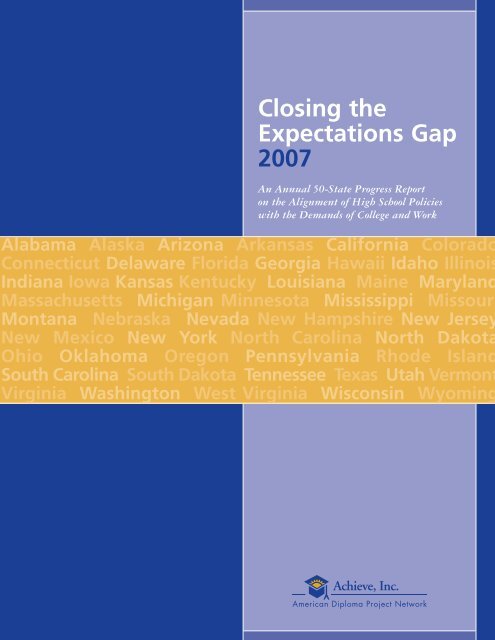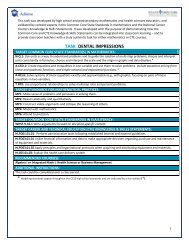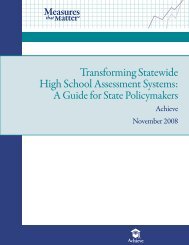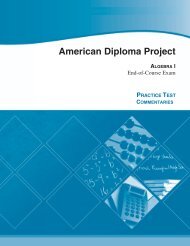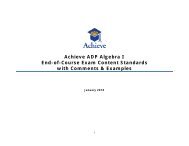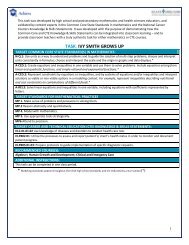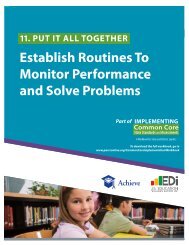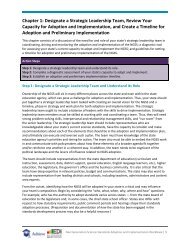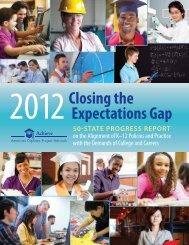Closing the Expectations Gap 2007 - Achieve
Closing the Expectations Gap 2007 - Achieve
Closing the Expectations Gap 2007 - Achieve
You also want an ePaper? Increase the reach of your titles
YUMPU automatically turns print PDFs into web optimized ePapers that Google loves.
<strong>Closing</strong> <strong>the</strong><strong>Expectations</strong> <strong>Gap</strong><strong>2007</strong>An Annual 50-State Progress Reporton <strong>the</strong> Alignment of High School Policieswith <strong>the</strong> Demands of College and WorkAlabama Alaska Arizona Arkansas California ColoradoConnecticut Delaware Florida Georgia Hawaii Idaho IllinoisIndiana Iowa Kansas Kentucky Louisiana Maine MarylandMassachusetts Michigan Minnesota Mississippi MissouriMontana Nebraska Nevada New Hampshire New JerseyNew Mexico New York North Carolina North DakotaOhio Oklahoma Oregon Pennsylvania Rhode IslandSouth Carolina South Dakota Tennessee Texas Utah VermontVirginia Washington West Virginia Wisconsin WyomingAmerican Diploma Project Network
About <strong>Achieve</strong>Created by <strong>the</strong> nation’s governors and business leaders,<strong>Achieve</strong>, Inc., is a bipartisan, non-profit organization tha<strong>the</strong>lps states raise academic standards, improve assessmentsand streng<strong>the</strong>n accountability to prepare all young peoplefor postsecondary education, work and citizenship. <strong>Achieve</strong>has helped more than half <strong>the</strong> states benchmark <strong>the</strong>ir academicstandards, tests and accountability systems against<strong>the</strong> best examples in <strong>the</strong> United States and around <strong>the</strong>world. <strong>Achieve</strong> also serves as a significant national voice forquality in standards-based education reform and regularlyconvenes governors, CEOs and o<strong>the</strong>r influential leaders atNational Education Summits to sustain support for higherstandards and achievement for all of America’s schoolchildren.In 2005, <strong>Achieve</strong> co-sponsored <strong>the</strong> National EducationSummit on High Schools. Forty-five governors attended<strong>the</strong> Summit along with corporate CEOs and K–12 and postsecondaryleaders. The Summit was successful in making <strong>the</strong>case to <strong>the</strong> governors and business and education leadersthat our schools are not adequately preparing students forcollege and 21st-century jobs and that aggressive action willbe needed to address <strong>the</strong> preparation gap. As a result of <strong>the</strong>Summit, 29 states joined with <strong>Achieve</strong> to form <strong>the</strong> AmericanDiploma Project Network — a coalition of states committedto aligning high school standards, assessments, graduationrequirements and accountability systems with <strong>the</strong> demandsof college and <strong>the</strong> workplace.For more information, visit <strong>Achieve</strong>’s Web site atwww.achieve.org.Published in April <strong>2007</strong>.Copyright © <strong>2007</strong> <strong>Achieve</strong>, Inc. All rights reserved.No part of this publication may be reproduced or transmitted in anyform or by any means, electronic or mechanical, including photocopy,recording, or any information or storage retrieval system,without permission from <strong>Achieve</strong>, Inc.Editorial assistance and design: KSA-Plus Communications, Inc.
Table of ContentsExecutive Summary3Introduction5Align High School Standards with Real-World <strong>Expectations</strong>7Align High School Graduation Requirements withCollege and Workplace <strong>Expectations</strong>10Align High School and Postsecondary Assessments16Hold High Schools and Postsecondary InstitutionsAccountable for Student Success20Conclusion25Appendix: Key Questions Asked in <strong>Achieve</strong>’s Survey27Endnotes28<strong>Closing</strong> <strong>the</strong> <strong>Expectations</strong> <strong>Gap</strong> <strong>2007</strong> 1
Executive SummaryAt <strong>the</strong> 2005 National Education Summit on High Schools, governors from 45 statesjoined with business leaders and education officials to address a critical problem inAmerican education: Too few high school students graduate prepared for <strong>the</strong> demands ofpostsecondary education and 21st-century jobs. At <strong>the</strong> Summit, it was widely acknowledgedthat if states do not dramatically raise expectations and achievement in <strong>the</strong>ir highschools, America’s competitive position in <strong>the</strong> global economy could be at risk.The Summit has sparked real action.During <strong>the</strong> past two years, a majorityof governors have made it a top priorityto raise standards and improve <strong>the</strong>preparation of high school students.States have taken concrete steps toalign standards, raise graduationrequirements and increase <strong>the</strong> value of<strong>the</strong> high school diploma so that allstudents graduate better prepared forcollege and careers. One illustration ofthis commitment is <strong>the</strong> rapid growthin <strong>the</strong> number of states in <strong>the</strong>American Diploma Project (ADP)Network, an alliance of states launchedat <strong>the</strong> Summit to close <strong>the</strong> gapbetween <strong>the</strong> expectations students areheld to in high school and those <strong>the</strong>ywill face in college and <strong>the</strong> workplace.The Network began with 13 states; ithas now grown to 29 states thattoge<strong>the</strong>r educate nearly 60 percent of<strong>the</strong> nation’s public school children.The results are promising: States havemade steady progress over <strong>the</strong> past year,and a greater number have made highschool reform a priority this year.Highlights from ThisYear’s Survey• STANDARDS — Twelve states reportthat <strong>the</strong>ir high school standards arealigned with postsecondary expectations,more than doubling <strong>the</strong>number from a year ago. Thirty-twoadditional states report that <strong>the</strong>yare in <strong>the</strong> process of aligning <strong>the</strong>irstandards or plan to do so.Aligned standardsRigorous graduationrequirements• GRADUATION REQUIREMENTS —Thirteen states require students tocomplete a college- and work-readycurriculum to earn a diploma, 11more than in 2005. Sixteen o<strong>the</strong>rsreport plans to adopt college- andwork-ready diploma requirementsfor all students in <strong>the</strong> future.• TESTING — Nine states currentlyadminister college readiness teststo all high school students as partof <strong>the</strong>ir statewide assessment systems.Twenty-one o<strong>the</strong>r statesreport plans to do so in <strong>the</strong> future.A Growing Number of States Have Policies To Help Ensure that High SchoolStudents Graduate College and Work Ready587516322944<strong>Achieve</strong> is committed to helping stateson this important agenda and monitoringprogress nationwide. Prior to <strong>the</strong>second anniversary of <strong>the</strong> Summit,<strong>Achieve</strong> surveyed all 50 states about <strong>the</strong>status of <strong>the</strong>ir efforts to align high schoolstandards, graduation requirements,assessments and accountability systemswith <strong>the</strong> demands of college and work.High school testsused by collegesP–16 longitudinaldata systemHigh schools accountablefor college readiness3524 5482117420 10 20 30 40 50Source: <strong>Achieve</strong> Survey/Research, <strong>2007</strong>Note: For an overview of <strong>the</strong> policies in place in each state, see page 14.3047Number of states in 2006Number of additionalstates in <strong>2007</strong>Number of states inprocess/planning<strong>Closing</strong> <strong>the</strong> <strong>Expectations</strong> <strong>Gap</strong> <strong>2007</strong> 3
• P–16 DATA SYSTEMS — Five statesreport that <strong>the</strong>y have longitudinaldata systems capable of tracking anindividual student’s progress fromkindergarten through college graduation.All but three o<strong>the</strong>rs haveplans to develop such data systems.• ACCOUNTABILITY — Nine statesfactor college and work readinessinto <strong>the</strong>ir high school accountabilitysystems, providing incentives forimproving college-ready graduationrates. Eight o<strong>the</strong>r states plan tomove in this direction in <strong>the</strong> future.The most progress has occurred in <strong>the</strong>areas of standards and graduationrequirements. Nearly every state hasaligned — or is in <strong>the</strong> process ofaligning — <strong>the</strong>ir high school standardswith <strong>the</strong> expectations of college facultyand employers. One-quarter of <strong>the</strong> statesare requiring all students to completea college- and work-ready curriculumto earn a diploma; only two states hadsuch requirements in place in 2005.Most states also are working to developdata systems that can track <strong>the</strong>progress of individual students fromkindergarten through postsecondaryeducation, an essential component ofa strong accountability system.There has been less progress in highschool testing and accountability. Veryfew states are measuring whe<strong>the</strong>r <strong>the</strong>irhigh school students are ready for collegeand work, and few are makingcollege and work readiness part of <strong>the</strong>irhigh school accountability formulas.Without better assessments and incentivesfor schools to improve studentreadiness, necessary dramatic changesin U.S. high schools are not likely tooccur. Good standards simply are notenough; <strong>the</strong>se o<strong>the</strong>r integral policiesmust be in place, too.Given <strong>the</strong> complexity of this policyagenda and <strong>the</strong> multiyear effort it willtake to implement fully, state leadersmust maintain a sense of urgency. Ifstates are to succeed, this is what itwill take:Gubernatorial Leadership. For <strong>the</strong> pastfive years, No Child Left Behind hashad an impact on standards andaccountability reforms in elementaryand middle schools. At <strong>the</strong> high schoollevel, governors have claimed <strong>the</strong> leadershipmantle. The states that havemade <strong>the</strong> most progress almost alwayshave had <strong>the</strong> governor leading <strong>the</strong>charge. If states are going to continueto make progress, governors must continueto make this a top policy priority,bringing key stakeholders into <strong>the</strong>conversation and enlisting <strong>the</strong>ir support.Business leaders — longtimechampions for standards-based reform— are critical allies. They have aunique ability to help students, parents,educators and <strong>the</strong> public understand<strong>the</strong> demands of <strong>the</strong> global economy.The Ability To Move on Multiple Fronts.Developing and implementing goodpolicies takes time. Traditionally, stateshave taken <strong>the</strong>m on one by one, startingwith standards and <strong>the</strong>n movingto assessments, curriculum and, finally,accountability. As sensible as this progressionmay be, states will need to findways to move multiple pieces of <strong>the</strong>policy agenda simultaneously if <strong>the</strong>yare going to respond to <strong>the</strong> growingpressures of <strong>the</strong> wider world.Addressing Challenges. To implement<strong>the</strong> new expectations states are settingfor high school students successfully,states must take greater responsibilityfor providing teacher and student supports.States need to take on a new roleand create new types of partnershipswith local districts to meet capacityand student support challenges.Cross-State Partnerships. Whe<strong>the</strong>r <strong>the</strong>yare improving standards, raising graduationrequirements or working ono<strong>the</strong>r challenges, states have discoveredthat <strong>the</strong> issues <strong>the</strong>y face are remarkablysimilar. They have much to learnfrom each o<strong>the</strong>r. Increased opportunitiesfor networking and more formalpartnerships — such as <strong>the</strong> ADPAlgebra II exam initiative — willquicken <strong>the</strong> pace of reform.4<strong>Achieve</strong>, Inc.
IntroductionOur economy increasingly depends on high-skill jobs that require education andtraining beyond high school, but too few high school students graduate prepared for<strong>the</strong> demands of postsecondary education and <strong>the</strong> world of work.The statistics are alarming. Nationally,30 percent of high school students(and nearly 50 percent of black andLatino students) fail to earn adiploma. 1 Of those students who dograduate and enroll in college or enter<strong>the</strong> workforce, too many find <strong>the</strong>y lack<strong>the</strong> knowledge and skills necessary tosucceed. Nearly 30 percent of incomingfirst-year college students arerequired to enroll in remedial coursesin reading, writing or math. Only aminority of <strong>the</strong>se students end upearning a degree. 2This lack of preparation will have significantand long-lasting effects onindividuals and <strong>the</strong> economy. About67 percent of today’s new jobs requiresome postsecondary education or training,and that percentage is expected torise. 3 The result is that employmentopportunities for individuals withouteducation and skills are quickly disappearing,while jobs that pay well andsupport a middle-class lifestyle nowrequire higher-level skills than everbefore. If U.S. workers cannot meet<strong>the</strong> demand, U.S. competitivenesswill diminish, negatively affecting <strong>the</strong>living standards of millions of citizens.But even more is at stake. To becomeengaged and productive citizens in thisincreasingly knowledge-based world,students will need to comprehendcomplex written and ma<strong>the</strong>maticalinformation to make important decisionsabout issues such as <strong>the</strong>irfinances and health care. They willneed to communicate in sophisticatedways and use technology in <strong>the</strong>ir dailylives. Individuals who lack <strong>the</strong>se skillswill be left behind with few opportunitiesfor civic engagement. Stateshave a moral imperative and an economicincentive to better prepareyoung people for <strong>the</strong> world <strong>the</strong>y willenter after high school.All students must complete a rigorouscurriculum that prepares <strong>the</strong>m for successat two- and four-year colleges andin training programs necessary for jobsin <strong>the</strong> high-performance workplace.Unfortunately, states and school districtstoo often do not require all studentsto complete a college- and workreadycurriculum and routinely handout diplomas to students who lack <strong>the</strong>knowledge and skills <strong>the</strong>y need forsuccess after high school. <strong>Achieve</strong>’sAmerican Diploma Project (ADP)research identified an “expectations gap”— a gap between <strong>the</strong> requirements forearning a high school diploma and <strong>the</strong>must-have knowledge and skills neededfor college and careers.<strong>Closing</strong> <strong>the</strong> <strong>Expectations</strong><strong>Gap</strong>To address this gap, <strong>the</strong> leaders at <strong>the</strong>2005 National Education Summit onHigh Schools committed to a multiprongedaction agenda to raise academicstandards and graduation requirements,build stronger data and assessmentsystems, better prepare teachers,redesign high schools, and hold K–12and postsecondary schools accountablefor improved performance.Twenty-nine states — which toge<strong>the</strong>reducate nearly 60 percent of <strong>the</strong>nation’s children — are working with<strong>Achieve</strong> in <strong>the</strong> ADP Network on a coresubset of <strong>the</strong>se goals: to streng<strong>the</strong>nhigh school standards, curricula,assessments, and data and accountabilitysystems so that more students graduateready for college and 21st-century jobs.<strong>Achieve</strong> launched <strong>the</strong> Network at <strong>the</strong>Summit in partnership with governorsand education and business leaders from13 states. Since <strong>the</strong>n, an additional 16states have joined. In <strong>the</strong>se 29 states,governors, state education officials,business executives and higher educationleaders are working toge<strong>the</strong>r to improve<strong>the</strong> preparation of all students for successin college and <strong>the</strong> workplace. Leadersin <strong>the</strong>se states are committed to:<strong>Closing</strong> <strong>the</strong> <strong>Expectations</strong> <strong>Gap</strong> <strong>2007</strong> 5
American Diploma Project NetworkWAORNVCAAKMTIDWYUTCOAZ NMVTNDMNNYSDWIMIPAIANEOHIL INWV VAKS MO KYNCTNOK ARSCGAMS ALTXLAFLMENHMACTRINJDEMDHIADP Network state• Aligning high school standardswith <strong>the</strong> demands of college andwork;• Requiring students to complete acollege- and work-ready curriculumso that earning a diploma ensuresthat a student is ready for postsecondaryopportunities;• Building college- and work-readymeasures into statewide highschool assessment systems; and• Holding high schools and postsecondaryinstitutions accountablefor student preparation and success.A growing number of organizationsalso are working to help states accomplish<strong>the</strong> goals of <strong>the</strong> 2005 Summit.Increasingly, <strong>the</strong>se organizations ando<strong>the</strong>rs are speaking with one voiceabout <strong>the</strong> critical need to streng<strong>the</strong>nAmerica’s high schools and improve<strong>the</strong> readiness of <strong>the</strong>ir graduates.<strong>Achieve</strong>’s Second AnnualSurvey of State PoliciesTo monitor state progress in closing<strong>the</strong> expectations gap, <strong>Achieve</strong> surveysall 50 states each year on <strong>the</strong> key subsetof policies from <strong>the</strong> Summit actionagenda that form <strong>the</strong> basis for <strong>the</strong>ADP Network. 4 The survey specificallyasks about <strong>the</strong> progress states havemade in aligning standards with postsecondaryand workplace expectations;requiring a college- and career-readycurriculum for graduation; developingcollege- and career-ready assessments;and holding high schools and postsecondaryinstitutions accountable forstudents’ success in high school, collegeand beyond. Following is a closerlook at results from <strong>Achieve</strong>’s secondannual survey.6<strong>Achieve</strong>, Inc.
Align High School Standards with Real-World<strong>Expectations</strong>For <strong>the</strong> past 15 years, states have been developing and revising academic standards intendedto articulate <strong>the</strong> core knowledge and skills that students should learn from kindergartenthrough grade 12. These standards play an important role in <strong>the</strong> U.S. education system:They provide a foundation for decisions on curriculum, instruction and assessment, and <strong>the</strong>ycommunicate core learning goals to teachers, parents and students. Unfortunately, very fewstates anchored <strong>the</strong>ir K–12 standards in <strong>the</strong> skills necessary for postsecondary success, so<strong>the</strong>se “first generation” standards have had a limited impact on <strong>the</strong> preparation of highschool students for college and careers.Aligning high school standards withcollege and workplace expectations canbe accomplished only with <strong>the</strong> formalinvolvement of <strong>the</strong> postsecondary andbusiness communities. Working withK–12 educators, postsecondary systemsmust clearly define <strong>the</strong> skills that highschool graduates need to be ready totake and succeed in credit-bearing,non-remedial courses; business leaders,likewise, must articulate <strong>the</strong> skillsthat graduates need to be successfuland advance in <strong>the</strong>ir careers. High schoolstandards <strong>the</strong>n need to be anchored in<strong>the</strong>se real-world expectations.Progress Since <strong>the</strong> SummitSince 2005, 44 states have committedto re-examining <strong>the</strong> alignment of <strong>the</strong>irhigh school standards to ensure that<strong>the</strong>y reflect <strong>the</strong> knowledge and skillsthat high school graduates need to besuccessful in college and <strong>the</strong> workplace.Among <strong>the</strong>se are <strong>the</strong> 29 statesin <strong>Achieve</strong>’s ADP Network.• Twelve states report that <strong>the</strong>ir highschool standards are aligned withreal-world expectations, more thandoubling <strong>the</strong> number from a yearago, on <strong>the</strong> first anniversary of <strong>the</strong>2005 Summit. Then only fivestates — California, Indiana,Nebraska, New York and Wyoming— reported that <strong>the</strong>y had aligned<strong>the</strong>ir high school standards. Thisyear, seven new states — Arkansas,Delaware, Kentucky, Louisiana,Michigan, Rhode Island and WestVirginia — report having alignedand adopted college- and careerreadyhigh school standards.<strong>Achieve</strong> has reviewed formally orverified <strong>the</strong> standards in Arkansas,California, Indiana, Kentucky,Louisiana, Michigan and RhodeIsland and found that <strong>the</strong>y are well2006 <strong>2007</strong>5 7 27 5aligned with <strong>the</strong> college- andcareer-ready knowledge and skillsdefined in <strong>the</strong> ADP benchmarks. 5• Twenty-seven states report that<strong>the</strong>y are in <strong>the</strong> process of aligning<strong>the</strong>ir standards. Ten of <strong>the</strong> 27states report that <strong>the</strong>ir alignmentprocess is expected to concludesome time this year.• Five additional states report plans toalign <strong>the</strong>ir standards with collegeandcareer-ready expectations:Connecticut, Mississippi, Montana,South Dakota and Utah.• Only six states — Alaska, Illinois,Iowa, Missouri, North Dakota andVermont — report that <strong>the</strong>y have noMany States Are Aligning College- and Work-Ready High School StandardsIn process ofaligningPlan toalign5 12 39 44Number of statesSource: <strong>Achieve</strong> Survey/Research, <strong>2007</strong>Alignment complete<strong>Closing</strong> <strong>the</strong> <strong>Expectations</strong> <strong>Gap</strong> <strong>2007</strong> 7
Standards Alignment by StateCAAKORplans to re-examine <strong>the</strong>ir high schoolstandards to ensure that <strong>the</strong>y alignwith <strong>the</strong> expectations of <strong>the</strong> highereducation and business communities.ChallengesWANVMTWYCONMPostsecondary and BusinessEngagementFor <strong>the</strong> alignment process to be successful,states’ postsecondary andbusiness communities must play aformal role. The value of <strong>the</strong>ir rolehinges on <strong>the</strong> ability of postsecondaryand business representatives to ensurethat <strong>the</strong> standards produced reflect<strong>the</strong> demands of higher education andemployers and engender real buy-infrom those communities. <strong>Achieve</strong> hasworked with — or is currently workingwith — 23 states to align <strong>the</strong>irstandards, and each state has madehigher education and businessinvolvement a top priority.In Georgia and Louisiana, for instance,postsecondary representatives areequal partners at <strong>the</strong> table withK–12, defining <strong>the</strong>ir expectations forIDAZUTHISource: <strong>Achieve</strong> Survey/Research, <strong>2007</strong>VT MENDNHMNNY MASDWIMICTRIPAIANJNEOHIL INDEWV VA MDKS MO KYNCTNOK ARSCStandards aligned —GAreviewed formally orMS ALverified by <strong>Achieve</strong>TX LAState reports alignedFL standardsAlignment in processPlans to alignstandardsincoming students and helping toshape <strong>the</strong> new high school standards.They understand <strong>the</strong> necessity ofadopting a single set of college-readystandards across all postsecondaryinstitutions, ra<strong>the</strong>r than differentstandards for each institution. As partof <strong>the</strong> process, postsecondary representativeshave reviewed syllabi andstudent work from freshman coursesto clarify expectations for success inthose courses. They also have analyzeddata on high school course-taking andpostsecondary success. The highereducation systems in <strong>the</strong>se states viewthis work as part of a larger strategyfor increasing <strong>the</strong> number of studentswho can enter <strong>the</strong>ir institutions preparedto succeed. Not only have <strong>the</strong>yhelped shape <strong>the</strong> high school standards,but <strong>the</strong>y also plan to use those standardsin teacher training programsand as part of <strong>the</strong> process for placingstudents in credit-bearing courses.Engaging employers in <strong>the</strong> alignmentwork has proven more challenging forstates. Unlike colleges, employers arenot in <strong>the</strong> business of defining educationstandards. During <strong>the</strong> originalresearch phase of ADP, <strong>Achieve</strong> and itspartners brought toge<strong>the</strong>r focusgroups of employers from across <strong>the</strong>participating states to review drafts of<strong>the</strong> readiness benchmarks as <strong>the</strong>y werebeing developed. The goal was toensure that <strong>the</strong> standards reflected <strong>the</strong>core set of skills necessary for workreadiness and to identify specific standardsthat are especially critical forparticular jobs. It was more efficientand effective to ask employers to reactto draft standards than to create <strong>the</strong>irown from scratch.Vertical AlignmentOnce expectations at <strong>the</strong> end of highschool are aligned with <strong>the</strong> expectationsof colleges and employers, statesmust <strong>the</strong>n back-map <strong>the</strong>ir standardsfrom <strong>the</strong> end of high school all <strong>the</strong>way down through <strong>the</strong> lower grades toensure that <strong>the</strong>ir K–12 standards arevertically aligned. This may requirerevising high school standards as wellas standards for elementary and middleschool. The goal is to have a systemof standards that reflects a steady progressionof knowledge and skills culminatingin college and work readiness.To assist states in this work, <strong>Achieve</strong>is creating a set of model standards inEnglish and ma<strong>the</strong>matics that areanchored in <strong>the</strong> ADP end-of-highschoolbenchmarks. The math standardswill be grade by grade from kindergartenthrough grade 8 and course bycourse in high school. The Englishstandards will reflect a continuum frommiddle school through high school.8<strong>Achieve</strong>, Inc.
Lessons from Aligning High SchoolStandards with <strong>the</strong> Demands ofCollege and WorkThe 29 states in <strong>Achieve</strong>’s ADP Network are committed toaligning <strong>the</strong>ir high school standards with what it takes tosucceed in postsecondary education and <strong>the</strong> workplace.The goal of this effort is to ensure that students whomeet high school standards are prepared to enter andsucceed in credit-bearing courses in two- or four-year collegesor gain entry-level positions in high-skill jobs thatoffer opportunities to advance.An important step in this process is for K–12 leaders towork with a broad spectrum of postsecondary and businessleaders to define <strong>the</strong> core reading, writing and ma<strong>the</strong>maticsknowledge and skills graduates need to be ready for collegeand work. When actively engaged in determining <strong>the</strong>standards for readiness, postsecondary and business leaderscan help ensure that students are better prepared forwhat awaits <strong>the</strong>m after high school. Since February 2005,<strong>Achieve</strong> has worked with — or is currently working with —23 ADP states in <strong>the</strong>ir efforts to create standards that meetthis goal.Already, important lessons are emerging:English Language Arts• Although high school English standards and coursestend to emphasize literature, most of <strong>the</strong> reading studentswill encounter in college or on <strong>the</strong> job is informationalin nature (e.g., textbooks, manuals, articles,briefs and essays).• Most of <strong>the</strong> writing students will do in college andwork is to inform or persuade, often requiring studentsto use evidence to support a position. Researchalso is cited as an important skill for college andwork. State standards tend to give <strong>the</strong>se types ofwriting short shrift, emphasizing narrative writinginstead.• The ability to work in teams and orally present one’swork is cited by professors and employers as criticalfor success. State standards do not always sufficientlycover <strong>the</strong>se skills.States Participating in <strong>Achieve</strong>’s Formal AlignmentReview ProcessCAAKORWANVIDAZUTMTHIWYCONMMa<strong>the</strong>maticsVT MENDNHMNNY MASDWIMICTRIPAIANJNEOHIL INDEWV VA MDKS MO KYNCTNOK ARSCStandardsGAMS ALaligned —TX LAformally reviewedFL by <strong>Achieve</strong>Alignment inprocess• College faculty and employers cite a broad range ofma<strong>the</strong>matics content as important, including numberconcepts, geometry, algebra, data analysis and statistics.State standards sometimes fall short on data analysisand statistics and often give only superficial treatmentto important geometric concepts, such as proofs.• Reasoning and solving ma<strong>the</strong>matical problems areoften cited as <strong>the</strong> most important skills for incomingfreshmen and employees. Yet state standards do notalways cover <strong>the</strong>m explicitly.K–12 leaders in ADP states — in partnership with postsecondaryand business leaders — are working to fill<strong>the</strong>se gaps. Successful efforts result in standards that are:• Adopted by <strong>the</strong> state board of education as defining<strong>the</strong> knowledge and skills in math and English that allstudents should acquire by <strong>the</strong> end of high school;• Adopted, endorsed or o<strong>the</strong>rwise recognized by statepostsecondary systems and institutions as defining<strong>the</strong> knowledge and skills necessary for placementinto credit-bearing courses; and• Verified or endorsed by employers and <strong>the</strong> businesscommunity as constituting skills necessary to enterand succeed in <strong>the</strong> 21st-century workplace.Over time, <strong>the</strong>se new college- and work-ready standardswill be incorporated into a range of state policies andpractices, such as high school graduation requirements,course descriptions, high school assessments, and postsecondaryplacement policies and assessments.<strong>Closing</strong> <strong>the</strong> <strong>Expectations</strong> <strong>Gap</strong> <strong>2007</strong> 9
Align High School Graduation Requirements withCollege and Workplace <strong>Expectations</strong>Research by <strong>Achieve</strong> and o<strong>the</strong>rs indicates that whe<strong>the</strong>r students go directly intocollege or <strong>the</strong> workforce after graduation, <strong>the</strong>y need a common core of knowledgeand skills in English and ma<strong>the</strong>matics.For high school graduates to be preparedadequately, <strong>the</strong>y need to takefour years of challenging ma<strong>the</strong>matics— at least through Algebra II or itsequivalent — and four years of rigorousEnglish aligned with college- andwork-ready standards. Although <strong>the</strong>most commonly used criterion forawarding a high school diploma continuesto be course-taking requirements,until recently, few states set<strong>the</strong>ir requirements at <strong>the</strong> appropriatelevel to ensure that graduates areprepared for success in college and<strong>the</strong> workplace.Progress Since <strong>the</strong> SummitIn late 2004, <strong>Achieve</strong> first reviewedhigh school course requirements andconcluded that only two states —Arkansas and Texas — had set <strong>the</strong>irrequirements at a level that wouldensure graduates are prepared for successin college and <strong>the</strong> workplace.Since <strong>the</strong>n, states have been movingrapidly to enact more rigorousrequirements.Kentucky, Michigan, New York,Oklahoma, South Dakota and Texas —had raised <strong>the</strong>ir graduation requirementsto <strong>the</strong> college- and work-readylevel. In <strong>the</strong> past year, an additionalfive states — Delaware, Minnesota,Mississippi, New Mexico and Ohio —have adopted college- and careerreadydiploma requirements for allstudents. Ano<strong>the</strong>r 16 states reportplans to adopt such curriculumrequirements for all students in <strong>the</strong>next few years.• An additional five states —Florida, Idaho, Iowa, Oregon andUtah — have raised <strong>the</strong>ir graduationrequirements in <strong>the</strong> past year,but not to <strong>the</strong> level recommendedby ADP in ma<strong>the</strong>matics. Althoughall five of <strong>the</strong>se states will nowrequire at least three years of math,none explicitly requires all studentsto complete a math course beyondAlgebra I and Geometry.ChallengesMandatory versus DefaultStates raising <strong>the</strong>ir course requirementsto <strong>the</strong> level recommended byADP have taken two differentapproaches. Many of <strong>the</strong> earlier statesto adopt college- and work-readycourse requirements for all incominghigh school students — includingArkansas, Indiana, Oklahoma, SouthDakota and Texas — set <strong>the</strong> curriculumas <strong>the</strong> “default” diploma option.With <strong>the</strong> default option, studentsautomatically enroll in <strong>the</strong> collegeandwork-ready curriculum but may“opt out” of <strong>the</strong> requirements if <strong>the</strong>irparents sign a waiver. Four of <strong>the</strong>states that have adopted a college- andwork-ready curriculum in <strong>the</strong> pastyear — Delaware, Minnesota, Mississippiand Ohio — have made <strong>the</strong> courserequirements mandatory for all studentswithout any opt-out provisions. Ohiowill have a four-year period duringMore States Have College- and Work-Ready Graduation Course Requirements• Thirteen states require students tocomplete a college- and workreadycurriculum, 11 more than in2005. By <strong>the</strong> first anniversary of<strong>the</strong> Summit a year ago, eightstates — Arkansas, Indiana,2006 <strong>2007</strong>8 5 16Plan to raiserequirements8 13 29Number of statesSource: <strong>Achieve</strong> Survey/Research, <strong>2007</strong>Course requirements in place10<strong>Achieve</strong>, Inc.
Status of Graduation Course Requirements by StateCAAKWAOR*NVID*AZUTMTWYCONMSource: <strong>Achieve</strong> Survey/Research, <strong>2007</strong>*Plans to raise requirements to <strong>the</strong> ADP level.which students may opt out of <strong>the</strong>new Ohio Core requirements withparental consent, but <strong>the</strong>n <strong>the</strong> Corewill become <strong>the</strong> mandatory curriculum.As states decide whe<strong>the</strong>r to create apolicy that permits students to opt outof <strong>the</strong> college- and work-ready curriculum,<strong>the</strong>y must confront two competingconcerns. On one hand, somestudents arrive in high school unpreparedfor rigorous courses, and an optoutprovision provides a safety valvefor those students, allowing <strong>the</strong>m totake a different set of courses and stillearn a diploma. On <strong>the</strong> o<strong>the</strong>r hand,policymakers worry that an opt-outprovision may encourage some schoolsor educators to counsel struggling studentsout of <strong>the</strong> rigorous coursesra<strong>the</strong>r than provide <strong>the</strong>m with <strong>the</strong>support and encouragement <strong>the</strong>y needto aim higher and succeed. This isparticularly a concern with disadvantagedstudents and o<strong>the</strong>rs who traditionallyhave been held to lowerexpectations.HIVT MENDNHMNNY MASDWIMICTRIPAIANJNEOHIL INDEWV VA MDKS MO KYNCTNOK ARSCGAMS ALCollege- and workreadydiploma in placeTX LAFL Raised requirements inpast year, but not toADP levelPlans to raise graduationrequirementsIt is important for states with opt-outprovisions to watch carefully to seewhich and how many students opt out as<strong>the</strong>y enter high school. In Oklahoma, 13percent of incoming 9th grade studentsopted out of <strong>the</strong> college-prep track <strong>the</strong>first year it counted. In Arkansas, 10 percentdid <strong>the</strong> same.Providing Student SupportsEven as states raise <strong>the</strong>ir graduationrequirements to meet 21st-centuryneeds, significant proportions of studentsenter high school substantiallybehind in <strong>the</strong>ir basic literacy and mathskills. More than two-thirds of 8thgraders score below proficient onNational Assessment of EducationalProgress (NAEP) reading and mathtests. Students who are fur<strong>the</strong>stbehind tend to be concentrated inhigh-poverty schools and districts. Itwill be much more difficult for poorlyprepared students to meet higherexpectations and complete high schoolthan <strong>the</strong>ir better-prepared peers.This is not a reason to lower expectations,however. It is a reason to provide<strong>the</strong> necessary support to strugglingstudents. Adolescent literacy programswill be required to help students succeedby streng<strong>the</strong>ning <strong>the</strong>ir literacyskills. Some students need help with<strong>the</strong> basics, while many more need helpdeveloping comprehension and writingskills, particularly in academiccontent areas. Students entering highschool with weak math skills will needextra help to succeed in Algebra I.Schools and districts are using a varietyof strategies to provide this support.For example, Chicago is offeringsummer bridge programs between 8thand 9th grades that provide opportunitiesfor review and acceleration, ideallywith <strong>the</strong> teacher that students willhave in <strong>the</strong> fall. Patterson High School inBaltimore uses double periods of mathto provide students time to catch upand offers courses to ease <strong>the</strong> transitionto high school.Skill development is necessary but willnot be sufficient for every student byitself. Schools should use early warningindicators to identify students whoare at risk of dropping out, such asstudents with precipitous drops inattendance and grades during <strong>the</strong> transitionsinto middle and high school orwho do not earn enough credits to bepromoted from 9th to 10th grade. 6These types of indicators can be usedto target interventions for at-risk studentsand can lead to programmaticchanges at <strong>the</strong> school or district levelto create more supportive and effectivelearning environments.<strong>Closing</strong> <strong>the</strong> <strong>Expectations</strong> <strong>Gap</strong> <strong>2007</strong> 11
Struggling students need <strong>the</strong>se ando<strong>the</strong>r supports, such as extendedlearning time and services, to addressnon-academic needs. They also needwell-prepared and effective teachers.There is growing evidence that schoolswith <strong>the</strong> greatest concentrations of disadvantagedstudents are most likely tohave <strong>the</strong> least-prepared, least-experiencedteachers. 7 States, districts and teachers’organizations need to work toge<strong>the</strong>r todevelop and implement <strong>the</strong> policies,contract provisions, incentives andworking conditions that help get <strong>the</strong>best-prepared teachers to <strong>the</strong> schoolswhere <strong>the</strong>y are most needed.States alone cannot deliver all of <strong>the</strong>needed services, and rarely is <strong>the</strong>re asingle agency or level of governmentresponsible for providing all of <strong>the</strong>sesupports within a state. But thatshould not be an excuse for inaction.The combined and coordinated effortsof state and local education agencies,institutions of higher education, andcommunity-based organizations arenecessary to provide students with <strong>the</strong>support <strong>the</strong>y need. States must provide<strong>the</strong> leadership and resources toensure that this happens.Ensuring ConsistentCourse RigorAs states raise course requirements,<strong>the</strong>y will need to put safeguards inplace to ensure that courses taught inhigh schools throughout <strong>the</strong> state areconsistently rigorous and aligned with<strong>the</strong> state standards. O<strong>the</strong>rwise, <strong>the</strong>content or instruction in <strong>the</strong> moreadvanced courses may become watereddown as more students are required totake <strong>the</strong>m.Recognizing this problem, states aretaking different approaches to ensureconsistent course content and rigor:• Twenty-nine states are pursuingend-of-course testing. Thirteenstates already have end-of-coursetests in place, and 16 more plan todevelop end-of-course tests tomeasure whe<strong>the</strong>r students havemastered <strong>the</strong> essential knowledgeand skills in core courses. Roughlyhalf of <strong>the</strong>se states currently haveor plan to have end-of-course testsin advanced courses such asAlgebra II and 11th grade English.• Thirty-eight states produce courselevelstandards, model curricula oro<strong>the</strong>r instructional materials forschools to guide classroom instruction.As states revise <strong>the</strong>ir highschool content standards, <strong>the</strong>yshould ensure that <strong>the</strong>se tools accuratelyreflect those expectationsand that <strong>the</strong>y are broadly accessible.Rhode Island has created a statewideapproach to validating local districtcourses’ alignment with <strong>the</strong> statehigh school standards. Beginning thisspring, <strong>the</strong> state will review all districthigh school curricula to determinewhe<strong>the</strong>r <strong>the</strong>y are adequatelyaligned with <strong>the</strong> state standards. Thestate will endorse diplomas only indistricts where curricula meet statestandards. Delaware also plans torequire all districts to submit <strong>the</strong>ircourse content for review. Thisapproach may be more practical insmaller states. Larger states may considerconducting targeted audits orcreating tools to allow districts toconduct <strong>the</strong>ir own review of coursecontent in <strong>the</strong>ir high schools.Moving Beyond Carnegie UnitsToward Credit by ProficiencyCarnegie units measure seat time, notperformance. Performance is whatmatters. Some states are beginning tolook beyond Carnegie units at o<strong>the</strong>rways for students to demonstrate proficiencyand satisfy college- and workreadygraduation requirements. Thegoal in <strong>the</strong>se states is to ensure that allstudents master <strong>the</strong> college- and workreadycontent defined in state academicstandards, while also providing districts<strong>the</strong> flexibility to design and implementcourses and curricula as <strong>the</strong>y choose.In 2003, <strong>the</strong> Rhode Island Board ofRegents ushered in a new high schooldiploma system, requiring all studentsto demonstrate proficiency in “corecontent knowledge” and “appliedlearning skills” in English languagearts, ma<strong>the</strong>matics, science, social studies,<strong>the</strong> arts and technology alignedwith state standards. Core contentknowledge proficiency will be determinedmainly through performance onassessments, but students may also useprojects, portfolios and course grades.Proficiency in <strong>the</strong> applied learningskills will be determined by an evenwider array of demonstrations, includingspeeches, projects, performances,essays, collections of short stories orjournals.Ano<strong>the</strong>r example is Pennsylvania, where<strong>the</strong> Governor’s Commission on Collegeand Career Success recently issued itsfinal report of high school reform recommendationsdesigned to raise12<strong>Achieve</strong>, Inc.
achievement for all students within atraditional local control framework.The first recommendation wouldrequire all students to demonstrateproficiency on <strong>the</strong> state’s academicstandards in <strong>the</strong> core subjects by ei<strong>the</strong>rpassing a series of state-developed,end-of-course tests — <strong>the</strong> GraduationCompetency Assessments (GCAs) —or scoring proficient or above on <strong>the</strong>11th grade Pennsylvania System ofSchool Assessment. Although studentswould be able to decide which assessmentsystem to use to demonstrateproficiency, all districts would berequired to administer <strong>the</strong> GCAs in<strong>the</strong> core subjects.As States Raise High School GraduationRequirements in Math, Do O<strong>the</strong>r Subjects GetSqueezed from <strong>the</strong> Curriculum?Each of <strong>the</strong> 13 states that have raised graduation course requirements to<strong>the</strong> level recommended by ADP has raised <strong>the</strong> requirements primarily inmath because deficiencies in high school graduates’ math performance aremost glaring to employers and postsecondary institutions. Many also haveraised requirements in science. None of <strong>the</strong> states has cut back on requirementsin <strong>the</strong> humanities to make room for more math and science. Becausestudents need a well-rounded education, each of <strong>the</strong>se states also establishedcourse-taking requirements in English, history/social studies andcivics, and most specify requirements in foreign languages and <strong>the</strong> arts.College- and Work-Ready High School Graduation Course RequirementsAR DE IN KY MI MN MS NM NY OH OK SD TXEnglish 4.5 4 4 4 4 4 4 4 4 4 4 4 4.5Ma<strong>the</strong>matics(through atleast Algebra II)4 4 3 3 4 3 4 4 3 4 3 3 4Science 3 3 3 3 3 3 4 3 3 3 3 3 4Social studies 3 3 3 3 3 3.5 4 3.5 4 3 3 4 4Fine arts* 0.5 01 1 1 1 0 11 1 1Foreignlanguage*0 2 0 2 0 07162Career tech,electives ando<strong>the</strong>r courses*9.59 77 8 8 1 7 7 6 6.5Totalrequiredcourses22 24 20 22 18 21.5 24 24 22 20 23 22 26Firstgraduatingclass affected2010 2011 2011 2012 2016 2015 2012 2013 2010 2014 2010 2010 2011Source: <strong>Achieve</strong> Survey/Research, <strong>2007</strong>* States approach elective requirements in a variety of ways. They may specify that students completeelectives chosen from a set of prescribed courses or subjects that in some states includesfine arts and foreign language. They also may bundle electives into various course sequences orconcentrations from which students choose. Finally, states simply may require students to take anumber of electives without any structure of specificity. A number of states combine <strong>the</strong>seoptions, requiring several prescribed elective courses or a choice from among several elective concentrations,while also providing students with flexibility in how <strong>the</strong>y fulfill <strong>the</strong> remaining electives.“O<strong>the</strong>r courses” include health, physical education and o<strong>the</strong>r required non-academic courses.<strong>Closing</strong> <strong>the</strong> <strong>Expectations</strong> <strong>Gap</strong> <strong>2007</strong> 13
14<strong>Achieve</strong>, Inc.Overview of Key Survey Results for Each StateALAKAZARCACOCTDEFLGAHIIDILINIAKSKYLAMEMDMAMIMNMSMOMTNENVNHNJNMNYNCNDOHOKORPARISCSDTNTXUTVTVAWAWVWIWYStateAlign high school standardswith college and workplaceexpectationsAlign high school graduationrequirements with college andworkplace expectationsUse high schooltests for college placementDevelop a P–16longitudinal data systemTOTAL YES 12 13 9 5TOTALPLAN/PROCESS32 16 21 42
Hold high schools accountablefor graduating students collegeand work readyPolicies in place 2006 Policies in place <strong>2007</strong> State●●●●● ●●●●● AL●●●●● ●●●●● AK●●●●● ●●●●● AZ●●●●● ●●●●● AR●●●●● ●●●●● CA●●●●● ●●●●● CO●●●●● ●●●●● CT●●●●● ●●●●● DE●●●●● ●●●●● FL●●●●● ●●●●● GA●●●●● ●●●●● HI●●●●● ●●●●● ID●●●●● ●●●●● IL●●●●● ●●●●● IN●●●●● ●●●●● IA●●●●● ●●●●● KS●●●●● ●●●●● KY●●●●● ●●●●● LA●●●●● ●●●●● ME●●●●● ●●●●● MD●●●●● ●●●●● MA●●●●● ●●●●● MI●●●●● ●●●●● MN●●●●● ●●●●● MS●●●●● ●●●●● MO●●●●● ●●●●● MT●●●●● ●●●●● NE●●●●● ●●●●● NV●●●●● ●●●●● NH●●●●● ●●●●● NJ●●●●● ●●●●● NM●●●●● ●●●●● NY●●●●● ●●●●● NC●●●●● ●●●●● ND●●●●● ●●●●● OH●●●●● ●●●●● OK●●●●● ●●●●● OR●●●●● ●●●●● PA●●●●● ●●●●● RI●●●●● ●●●●● SC●●●●● ●●●●● SD●●●●● ●●●●● TN●●●●● ●●●●● TX●●●●● ●●●●● UT●●●●● ●●●●● VT●●●●● ●●●●● VA●●●●● ●●●●● WA●●●●● ●●●●● WV●●●●● ●●●●● WI●●●●● ●●●●● WY9 15 218 3 71 OR 2 POLICIESIN PLACEPolicy in placeIn process of aligning standardsPlans to implementADP Network state3 OR MOREPOLICIES IN PLACE <strong>Closing</strong> <strong>the</strong> <strong>Expectations</strong> <strong>Gap</strong> <strong>2007</strong> 15
Align High School and Postsecondary AssessmentsAs states align <strong>the</strong>ir high school standards and graduation requirements with <strong>the</strong> demandsof college and work, <strong>the</strong>y also must build assessments rigorous enough to measure collegeand work readiness. <strong>Achieve</strong>’s research suggests that few states have such assessments inplace today. Most high school tests, particularly those used for graduation, measureknowledge and skills students learn early in high school. Without sufficient emphasison <strong>the</strong> advanced high school content that students will need to be successful in college,state assessments will fall short of measuring readiness for postsecondary pursuits.To help prepare students academicallyfor a successful transition from secondaryto postsecondary education and <strong>the</strong> workplace,states need to go beyond <strong>the</strong>irexisting tests. They need a componentof <strong>the</strong>ir high school assessment systemsthat measures <strong>the</strong> more advanced skillsvalued by postsecondary institutions andemployers. If states build more rigorousassessments into <strong>the</strong>ir high school testingsystems, postsecondary institutionscan use <strong>the</strong>se exams to make placementdecisions. This will send a powerful andconsistent signal to students and schoolsabout what it takes to be ready.Progress Since <strong>the</strong> SummitAlthough states have made significantprogress in aligning high school standardsand course requirements withcollege and work, <strong>the</strong>y have madeless progress in upgrading high schoolassessments. A growing number ofstates, however, are planning to buildcollege- and work-ready assessmentsinto <strong>the</strong>ir high school testing andaccountability systems. Thirty statesreport that <strong>the</strong>y ei<strong>the</strong>r have or plan tohave such an assessment in place in<strong>the</strong> near future.• Nine states currently administertests as part of <strong>the</strong>ir statewide highschool assessment systems that alsoare used by higher education toplace incoming students.■ New York administers end-of-courseRegents Exams that are used forhigh school accountability andcollege placement.■ California and Texas have comprehensivehigh school assessments,taken by students in <strong>the</strong>11th grade, that are used forfreshman course placement inhigher education.■ Colorado, Idaho, Illinois, Kentucky,Maine and Michigan all have incorporateda national college admissionstest — <strong>the</strong> ACT or SAT —into <strong>the</strong>ir state’s assessment systems.Kentucky and Michigan haveboth adopted <strong>the</strong> ACT into <strong>the</strong>irassessment systems in <strong>the</strong> past year,while Idaho requires all students totake <strong>the</strong> SAT, ACT or COMPASS.• Twenty-one o<strong>the</strong>r states reportplans to build college- and workreadyassessments into <strong>the</strong>irstatewide testing systems.State Strategies for Assessing College Readiness of High School Students VaryAdvancedend-of-course teststo measurecollege readiness11819Number of states in 2006Number of additional states in <strong>2007</strong>Plan to implement testsComprehensivehigh school teststo measurecollege readiness257College admissionstests for all studentsto measure readiness3 31716<strong>Achieve</strong>, Inc.0 5 10 15 20 25 30 35 40 45 50Number of statesSource: <strong>Achieve</strong> Survey/Research, <strong>2007</strong>
State Strategies forCollege- and Work-ReadyTestingA number of strategies are emergingas states work to build college-readytests into <strong>the</strong>ir high school assessmentsystems. The most widely pursuedstrategy is end-of-course tests. O<strong>the</strong>rstates are considering modifying <strong>the</strong>irexisting high school tests to make<strong>the</strong>m better measures of postsecondaryreadiness. Finally, a number of statesare incorporating <strong>the</strong> ACT or SATinto <strong>the</strong>ir assessment systems andrequiring all students to take thoseexams.It is too early to tell which strategieshold <strong>the</strong> most promise. Whicheverpath states pursue, <strong>the</strong> assessmentsmust meet two important goals: Theymust measure college and workplacereadiness adequately, and <strong>the</strong>y mustalign well with <strong>the</strong> state high schoolstandards. If ei<strong>the</strong>r goal is sacrificed,<strong>the</strong> value of <strong>the</strong> assessments will becompromised, and <strong>the</strong>ir impact onstudent preparation will be limited.Using High School End-of-Course Exams To Signal CollegeReadinessEighteen states are planning to developend-of-course assessments in advancedhigh school courses that will measurecollege readiness. One state — NewYork — already has such exams inplace. New York is <strong>the</strong> only state inwhich postsecondary institutions find<strong>the</strong> state’s end-of-course high schooltests — <strong>the</strong> Regents Exams — challengingenough to determine whe<strong>the</strong>rincoming students are prepared toStrategies for Assessing CollegeReadiness by StateStateAZARCACOCTFLGAHIIDILINKYLAMEMDMAMIMNMSNJNMNYOHOKORPARITXVAWVEnd-of-coursetests used forcollege placementenroll in credit-bearing courses. Forseveral years, <strong>the</strong> City University ofNew York (CUNY) has used scores on<strong>the</strong> Regents Exams for admissions andcourse placement decisions at its fouryearinstitutions. 8 According to stateofficials, <strong>the</strong> State University of NewYork system (SUNY) likewise hasadopted <strong>the</strong> use of <strong>the</strong> Regents Examsas a placement measure. This approachsignals to high school students interestedIn placeComprehensive highschool tests used for collegeplacementPlans to have in futureCollege admissions testsgiven to all high schoolstudentsin attending CUNY or SUNY thatperformance on <strong>the</strong> Regents Examswill have a direct impact on <strong>the</strong>irchances for success in college.Source: <strong>Achieve</strong> Survey/Research, <strong>2007</strong>The 18 o<strong>the</strong>r states that are planningto create end-of-course exams willneed to administer <strong>the</strong> tests in higherlevelcourses, such as Algebra II and11th grade English. Unfortunately,most states with end-of-course exams<strong>Closing</strong> <strong>the</strong> <strong>Expectations</strong> <strong>Gap</strong> <strong>2007</strong> 17
do not currently have tests at this level.For <strong>the</strong> tests to serve as true collegereadiness measures, higher educationmust help develop and/or review <strong>the</strong>seexams to ensure <strong>the</strong>y reflect <strong>the</strong> skillsneeded for college success.One reason end-of-course tests aregrowing in popularity is that <strong>the</strong>y canbe tied to <strong>the</strong> curriculum standardsand courses students are required totake to graduate. The tests also aremore sensitive to instruction because<strong>the</strong>y are taken right after a studentcompletes a course. End-of-course testsalso allow states to monitor rigor consistencyin courses taught statewide.There are challenges associated wi<strong>the</strong>nd-of-course testing, however. First,this approach could increase <strong>the</strong> amountof testing required by a state, dependingon <strong>the</strong> number of courses for which<strong>the</strong> state develops an assessment. Second,<strong>the</strong> content of end-of-course tests foradvanced courses might be right but<strong>the</strong> timing might not be from highereducation’s perspective. For example,if students take Algebra II in <strong>the</strong> 10thgrade — two years before enteringcollege — higher education institutionswould need to determinewhe<strong>the</strong>r results on that test could beused for placement or whe<strong>the</strong>r additionalinformation (e.g., evidence ofcontinued course-taking in advancedma<strong>the</strong>matics or additional measureslater in high school) would be needed.Setting a College-Ready CutScore on Comprehensive HighSchool ExamsTwo states use <strong>the</strong>ir comprehensive highschool assessments as college-readymeasures; five o<strong>the</strong>r states are consideringthis strategy.• California has amended its 11thgrade assessments to make <strong>the</strong>msufficient for signaling collegereadiness. As a result, <strong>the</strong> CaliforniaState University (CSU) system uses<strong>the</strong>se tests for course placement.• Texas uses <strong>the</strong> same assessment —<strong>the</strong> 11th grade Texas Assessment ofKnowledge and Skills (TAKS) —as both <strong>the</strong> high school graduationtest and a college placement exam. 9• Five additional states — Connecticut,Florida, Georgia, Minnesota andRhode Island — plan to review<strong>the</strong>ir existing comprehensive highschool assessments to determinewhe<strong>the</strong>r <strong>the</strong>y are capable of signalingcollege readiness.Building on <strong>the</strong> state’s 11th gradestandards-based tests in English andma<strong>the</strong>matics, <strong>the</strong> CSU system andCalifornia’s education departmentworked toge<strong>the</strong>r to design additionaltest questions that are aligned to <strong>the</strong>state’s 11th grade standards and assess<strong>the</strong> advanced skills incoming freshmenneed to be successful in entry-levelcourses. Students who score well onthat 11th grade test and continue totake challenging courses in <strong>the</strong>ir senioryear of high school are exempt from <strong>the</strong>CSU-required ma<strong>the</strong>matics and Englishplacement tests. The amended 11thgrade exams also serve to alert highschool students in time to adjust <strong>the</strong>irsenior-year coursework if <strong>the</strong>y needadditional preparation for college.Through <strong>the</strong> Texas Success Initiative,Texas set a college-ready cut score on<strong>the</strong> 11th grade TAKS that, if reached,indicates that <strong>the</strong> student will notrequire remediation at a state institutionof higher education. Texas setsone passing score for high schoolgraduation and a higher cut score todetermine whe<strong>the</strong>r students are readyfor credit-bearing college courses.Georgia plans to move in a similardirection. The state is working to modify<strong>the</strong> Georgia High School GraduationTest (GHSGT) to bring it into alignmentwith <strong>the</strong> new high school standardsand course requirements <strong>the</strong> stateexpects to adopt in <strong>the</strong> next two years.The goal is for <strong>the</strong> GHSGT to be rigorousenough and have a college- andwork-ready cut score that higher educationinstitutions can factor into placementdecisions.This strategy holds <strong>the</strong> most potentialin states that give <strong>the</strong>ir standardsbasedassessments in <strong>the</strong> 11th gradebecause those tests have <strong>the</strong> ability totap higher-level knowledge and skillsand because <strong>the</strong>y are taken closer to<strong>the</strong> end of high school when collegesare more likely to honor scores forplacement. This strategy would bemuch more difficult to pursue instates with 10th grade tests.Incorporating CollegeAdmissions Tests into HighSchool Testing SystemsSix states are incorporating national collegeadmissions tests (<strong>the</strong> ACT andSAT) into <strong>the</strong>ir high school assessmentsystems, requiring all students — notjust <strong>the</strong> college bound — to take <strong>the</strong>m.18<strong>Achieve</strong>, Inc.
• Four states — Colorado, Illinois,Kentucky and Michigan — haveincorporated or are in <strong>the</strong> process ofincorporating <strong>the</strong> ACT into <strong>the</strong>irhigh school assessment systems.• One state — Maine — has incorporated<strong>the</strong> SAT into its high schoolassessment system.• Idaho will now require all highschool students to take <strong>the</strong> ACT,SAT or COMPASS placement test.• West Virginia reports that it plans toadopt a policy that builds collegeadmissions tests into its highschool assessment system.Given <strong>the</strong> widespread use of <strong>the</strong> ACTand SAT for college admissions and<strong>the</strong> credibility <strong>the</strong>se tests have in <strong>the</strong>postsecondary community and <strong>the</strong>broader public, it is understandablethat states would consider <strong>the</strong>m foruse in high schools. Giving all students<strong>the</strong> opportunity to take <strong>the</strong>se testsmay encourage students who did notview <strong>the</strong>mselves as college material topursue that path. Also, because mostcollege-bound students already takeone of <strong>the</strong>se tests in high school,incorporating <strong>the</strong>m into an assessmentsystem will not increase <strong>the</strong> number oftests <strong>the</strong>se students need to take.There are, however, challenges associatedwith this strategy. In a recentreport, <strong>Achieve</strong> analyzed <strong>the</strong> mostcommonly used college admissionsand placement tests with an eyetoward <strong>the</strong>ir use in statewide highschool assessment systems. The analysisrevealed that although admissionstests do some things very well, <strong>the</strong>reare gaps in what <strong>the</strong>y measure. 10Nei<strong>the</strong>r <strong>the</strong> ACT nor <strong>the</strong> SAT includes<strong>the</strong> full range of advanced conceptsand skills reflected in <strong>the</strong> ADP benchmarksand, increasingly, in state highschool standards. Therefore, simplyincorporating <strong>the</strong>se tests as <strong>the</strong>y areinto state high school testing systemsis an insufficient strategy.To be effective, states need to augment<strong>the</strong> ACT and SAT with additionalquestions or performance measures toensure stronger alignment with statestandards and to assess <strong>the</strong> moreadvanced concepts and skills that collegefaculty say are important. Statesare approaching augmentation in differentways. Maine, for example, isCommon Algebra II Testadministering an augmented form of<strong>the</strong> SAT to all 11th grade students.The state worked with <strong>the</strong> CollegeBoard to develop supplemental itemsin data and statistics — an area ofma<strong>the</strong>matics that is covered in <strong>the</strong>state standards but not extensivelyassessed on <strong>the</strong> SAT. Similarly,Michigan administers <strong>the</strong> ACT andWorkKeys to all 11th graders, alongwith 15 additional ma<strong>the</strong>matics itemsthat measure content not covered onei<strong>the</strong>r test. Kentucky plans to administerboth <strong>the</strong> ACT and <strong>the</strong> state assessmentto all students. To reduce testingtime, <strong>the</strong> state has analyzed both testsand will eliminate items from <strong>the</strong>state test that cover content measuredby <strong>the</strong> ACT.<strong>Achieve</strong> is working with nine states to develop and administer a commonAlgebra II end-of-course test. The nine states — Arkansas, Indiana,Kentucky, Maryland, Massachusetts, New Jersey, Ohio, Pennsylvania andRhode Island — are partners in <strong>the</strong> ADP Network.The test is being developed based on a set of content specifications thatwere created jointly by <strong>the</strong> states — and are aligned with <strong>the</strong> ADPbenchmarks. The specifications include a common core of content thatwill be given across all states, plus a few modules that give states <strong>the</strong>flexibility to go beyond <strong>the</strong> core.This collaborative effort provides participating states with a number ofbenefits. First, <strong>the</strong> test will promote consistency and rigor in Algebra IIcourses within and among <strong>the</strong> states, which is important for equity acrossdiverse schools. Second, <strong>the</strong> test will serve as an indicator to studentsthat <strong>the</strong>y are prepared for college-level work and can be used by postsecondaryinstitutions to place students into credit-bearing ma<strong>the</strong>maticscourses. Third, <strong>the</strong> test will allow <strong>the</strong> public to compare <strong>the</strong> performanceof students across states. <strong>Achieve</strong> anticipates that, over time, additionalstates will administer <strong>the</strong> Algebra II end-of-course test, making comparisonseven more powerful.<strong>Closing</strong> <strong>the</strong> <strong>Expectations</strong> <strong>Gap</strong> <strong>2007</strong> 19
Hold High Schools and Postsecondary InstitutionsAccountable for Student SuccessThe mission of high schools is to prepare all students for college, careers and citizenship.Unfortunately, preparedness is barely a factor in high school accountability systems— if it is even measured at all. In most states, accountability models are driven byattendance, graduation rates, and performance on high school assessments that often arenot adequate measures of college and work readiness.The ability of states to hold highschools accountable for improving studenttransitions to college and workdepends on <strong>the</strong> quality of <strong>the</strong>ir assessmentsand data systems. States needmore reliable measures of college andwork readiness, including more robusthigh school assessments, as alreadydiscussed. They also need a longitudinaldata system with <strong>the</strong> capacity totrack student progress from highschool through postsecondary education.With such capacity, states will beable to trace a student’s postsecondarysuccess (or failure) back to his or herhigh school experience and use thatinformation to streng<strong>the</strong>n <strong>the</strong> experiencefor <strong>the</strong> next class of students. Aneffective longitudinal data systemwould enable policymakers to comparehigh school course-taking, grades andassessment results with college coursetakingpatterns, success in first-yearcollege courses, and persistence andcompletion rates.Progress Since <strong>the</strong>Summit: P–16 LongitudinalData SystemsLast year, only three states reportedhaving a P–16 longitudinal data systemin place, with 31 states reportingthat <strong>the</strong>y were working to establishsuch systems. This year — based on<strong>the</strong> responses to <strong>Achieve</strong>’s survey anddata from <strong>the</strong> Data Quality Campaignand <strong>the</strong> National Center for HigherEducation Management Systems —two additional states report havingoperational longitudinal data systemscapable of connecting student-levelcohort data from K–12 and highereducation. 11 An additional 42 statesreport plans to have data systems withthis capacity operational in <strong>the</strong> nextfew years, bringing <strong>the</strong> total number ofstates that have or plan to build P–16data systems to 47.• Five states report that <strong>the</strong>y haveonline P–16 longitudinal datasystems capable of tracking anindividual student’s progress fromkindergarten through college graduation.One year ago, only Florida,Louisiana and Texas had such systemsin place; this year two newstates — Arkansas and Massachusetts— report that <strong>the</strong>y have new operationalP–16 longitudinal datasystems. Florida’s P–20 data systemalso includes employment data,providing a body of data linkingsuccess in school to success in <strong>the</strong>workplace.Almost All States Plan To Implement P–16 Longitudinal Data Systems2006 <strong>2007</strong> Plan to implement data systems3 2423 5Number of states47Data systems in placeSource: <strong>Achieve</strong> Survey/Research, <strong>2007</strong>20<strong>Achieve</strong>, Inc.
Status of P–16 Longitudinal Data Systems by StateCAAKORWANV• Eight additional states — Alabama,Delaware, Georgia, Hawaii, Nevada,Tennessee, Utah and Wisconsin —report that <strong>the</strong>y can match individualstudent records from K–12longitudinal data systems withthose students’ records in <strong>the</strong> highereducation data systems, giving<strong>the</strong>m <strong>the</strong> capacity to trace studentachievement in higher educationback to <strong>the</strong> feeder high schools.Each of <strong>the</strong>se states has plans tobuild seamless longitudinal datasystems that will include K–12and higher education data.• Thirty-four more states have plans todevelop or make operational P–16longitudinal data systems that monitorindividual students’ progressthrough elementary, secondary andpostsecondary education.• The remaining three states —Alaska, Vermont and West Virginia —report having no plans to adoptP–16 longitudinal data systems.IDAZUTMTHISource: <strong>Achieve</strong> Survey/Research, <strong>2007</strong>WYCONMVT MENDNHMNNY MASDWIMICTRIPAIANJNEOHIL INDEWV VA MDKS MO KYNCTNOK ARSCGAMS ALTXLAFLChallengesP–16 longitudinal datasystems in placePlanning P–16 longitudinaldata systemsWorking in <strong>the</strong> Context ofPrivacy LawsAs states continue to develop P–16longitudinal systems that focus onindividual students’ growth and success,care must be taken to ensure thiswork can be done in accordance with<strong>the</strong> federal Family Education Rightsand Privacy Act (FERPA) to protectstudent privacy. Although FERPAlimits a state’s ability to disclose individualstudents’ records in some cases,<strong>the</strong> law does permit states to usestudent-level data to evaluate and auditstate and local programs for school anddistrict accountability; monitor andanalyze assessment, enrollment andgraduation data; perform studies toimprove instruction; share studentrecords among schools; and maintainteacher identification systems that linkteachers and students. AlthoughFERPA safeguards student privacy, itby no means prohibits states frombuilding robust P–16 longitudinaldata systems and using <strong>the</strong>m toimprove teaching and learning inhigh schools. 12Using Data To Raise<strong>Achieve</strong>ment and GraduationRatesAs states raise standards in high school,<strong>the</strong>y must pay close attention to <strong>the</strong>most vulnerable students — those at<strong>the</strong> greatest risk of dropping out — sothat <strong>the</strong>y receive <strong>the</strong> support necessaryto meet <strong>the</strong> higher standards andgraduate from high school. A growingbody of research suggests that welldesignedearly warning data systemsthat incorporate a variety of indicatorsfrom test scores and course grades toattendance and classroom engagementare effective tools for identifying studentsat risk of dropping out as earlyas 4th or 6th grade. 13 Such systemswould provide ample time for schoolsto intervene with supports and programsdesigned to help students getback on track. Additionally, analyzingteacher-level data can allow states,districts and schools to identify <strong>the</strong>strengths and weaknesses of individualteachers and to develop more tailoredprofessional development to improveinstruction. Florida, for example,recently developed a new data-driventeaching tool called SunshineConnections. Teachers have access tostudent performance data; classroommanagement tools; and interactiveconnections to o<strong>the</strong>r teachers, curricularmaterials and professional developmentopportunities. With proper training,teachers are able to use <strong>the</strong>se data toimprove student learning.<strong>Closing</strong> <strong>the</strong> <strong>Expectations</strong> <strong>Gap</strong> <strong>2007</strong> 21
Progress Since <strong>the</strong>Summit: AccountabilitySystemsAs more states begin to administercollege- and work-ready assessments toall students and develop <strong>the</strong> capacityto track student progress from highschool through postsecondary education,<strong>the</strong>y also need to create meaningfulaccountability systems that holdhigh schools responsible for graduatingstudents ready for college and <strong>the</strong>workplace. At a minimum, anaccountability system that measurescollege and work readiness should takeinto account an accurate graduationrate and whe<strong>the</strong>r students have completeda college- and work-ready curriculum;have demonstrated proficiencyon a college- and work-ready assessment;have enrolled in college; and havebeen placed into credit-bearing, nonremedialcourses in reading, writingand ma<strong>the</strong>matics.Measuring an Accurate HighSchool Graduation RateIn 2005, <strong>the</strong> National GovernorsAssociation (NGA) convened a taskforce to create a more valid, reliable andconsistent measure of <strong>the</strong> high schoolgraduation rate. All 50 governors signed<strong>the</strong> NGA Graduation Rate Compact,agreeing to develop a common, fouryear,adjusted-cohort graduation rate. 14Ra<strong>the</strong>r than rely on estimated graduationrates, <strong>the</strong> agreed-upon rate tracks<strong>the</strong> progress of each student, measures<strong>the</strong> percentage of students who graduatewithin four years of entering 9th gradeand measures <strong>the</strong> percentage of dropouts.This is an extremely important step.For <strong>the</strong> first time, it allows each stateto have an accurate picture of its performance.Governors who have takenoffice since <strong>the</strong> Compact was signedshould review <strong>the</strong>ir state’s efforts andprovide <strong>the</strong> necessary leadership toensure <strong>the</strong> development and use of thismeasure.Two-thirds of states factor or plan tofactor <strong>the</strong> NGA Compact graduationrate into <strong>the</strong>ir state high schoolaccountability formulas. This demonstratessignificant progress from lastyear when only a few states had adoptedor finalized plans for its use.This summer, <strong>the</strong> NGA will publishits annual report on <strong>the</strong> 50 states’progress in adopting and implementingthis graduation rate into <strong>the</strong>ir reportingand accountability systems, providingcomparable, up-to-date information.Holding High SchoolsAccountable for Whe<strong>the</strong>rStudents Earn College- andWork-Ready DiplomasBecause <strong>the</strong> mission of high school isto graduate all students ready for collegeand work, states must factor <strong>the</strong>percentage of students who graduatehaving completed a college- and workreadycurriculum into <strong>the</strong>ir accountabilitysystems.• Seven states — Delaware, Georgia,Indiana, New York, North Carolina,Oklahoma and Texas — hold highschools accountable for increasing<strong>the</strong> percentage of graduates whocomplete a college- and work-readycurriculum. In last year’s survey,only three states reported this aspart of <strong>the</strong>ir high school accountabilitysystems.• Five additional states have plans tofactor this indicator into <strong>the</strong>iraccountability systems.Few States Factor College Readiness into High School Accountability SystemsNumber of states in 2006Number of additional states in <strong>2007</strong>Graduatingwith college-readydiploma34 512Plan to hold schools accountableCollege-goingrate21 47Collegeremediation rate1 258Source: <strong>Achieve</strong> Survey/Research, <strong>2007</strong>0 5 10 15 20 25 30 35 40 45 50Number of states22<strong>Achieve</strong>, Inc.
• Ano<strong>the</strong>r dozen states publiclyreport <strong>the</strong> percentage of highschool students taking a collegeandwork-ready curriculum.Holding High SchoolsAccountable for <strong>the</strong> College-Going and Remediation Ratesof Their GraduatesA strong accountability system shouldprovide incentives to high schools toincrease <strong>the</strong> percentage of studentswho enroll in college and are placedinto credit-bearing courses that counttoward a degree. All too often, firstyearcollege students are required toenroll in remedial courses, and a largepercentage of those students will neverearn <strong>the</strong>ir postsecondary degrees.• Three states — Georgia, Missouriand Rhode Island — report that<strong>the</strong>y hold high schools accountablefor <strong>the</strong> college-going rates of <strong>the</strong>irgraduates.• Three states — Georgia, Oklahomaand Rhode Island — factor collegeremediation rates into <strong>the</strong>ir highschool accountability systems.• Five o<strong>the</strong>rs plan to factor collegegoingand remediation rates into<strong>the</strong>ir accountability systems.• An additional 21 states publiclyreport <strong>the</strong>ir college remediationrates but do not factor <strong>the</strong>m into<strong>the</strong>ir high school accountabilitysystems.How States Hold Schools Accountable forStudents’ College ReadinessStateARDEGAHIINLAMEMNMONJNYNCOKPARITXWIGraduating withcollege-ready diplomaFactoring College and WorkReadiness Tests intoAccountability Systems<strong>Achieve</strong> was interested in learningwhich states, if any, factor <strong>the</strong> percentageof high school students scoring“college and work ready” on a stateassessment into <strong>the</strong>ir high schoolaccountability systems. However,because few states have high schoolassessments in place that are capable ofmeasuring college and work readiness,this is difficult if not impossible formost states to accomplish right now.<strong>Achieve</strong> intends to return to this issuein <strong>the</strong> future and hopes to find examplesof states taking this importantpolicy step.College-going rateChallengesIn placePlans to have in futureCollege remediation rateFor states to implement effectiveaccountability systems that holdschools accountable for preparing allstudents for college and work, <strong>the</strong>ywill need better assessments and moresophisticated data systems. These willtake time to develop. But statesshould not wait for <strong>the</strong>m to be inplace before addressing <strong>the</strong> problemsin high schools and providing incentivesfor schools to improve.First Things First: Reduce <strong>the</strong>Dropout RateRegardless of what formula a statecurrently uses to measure graduationrates, every state knows which highSource: <strong>Achieve</strong> Survey/Research, <strong>2007</strong><strong>Closing</strong> <strong>the</strong> <strong>Expectations</strong> <strong>Gap</strong> <strong>2007</strong> 23
schools have <strong>the</strong> largest numbers ofdropouts. Those schools need immediateattention. One study estimatesthat half of <strong>the</strong> nation’s dropouts comefrom just 15 percent of America’s highschools. 15 States should target supportsand interventions in <strong>the</strong>se schools.States also need to create incentivesfor schools and districts to reduce <strong>the</strong>dropout rate by factoring it moresignificantly into <strong>the</strong>ir high schoolaccountability formulas. Louisiana’sAccountability Commission, for example,has planned an accountability systemthat encourages schools to focuson dropout prevention and recovery andto produce graduates who are collegeand career ready. Trying to correct <strong>the</strong>fact that schools often score higher ontest-driven accountability ratings when<strong>the</strong>y push low-performing students out,Louisiana will hold schools accountablefor dropout rates and studentachievement on <strong>the</strong> state assessments.Each student outcome — from droppingout of high school to graduatingwith academic or career/technicalendorsement — will be worth a certainamount of points on <strong>the</strong> “graduationindex” that goes into a school’saccountability rating. When studentsdrop out, schools will lose points. Thesystem also will encourage schools tocontinue working with students whofail to graduate within four years. If astudent upgrades his or her “outcome”after four years, <strong>the</strong> school’s accountabilityrating will reflect that increasein a student’s status.Provide Incentives for Collegeand Work ReadinessAll students should complete a collegeandwork-ready curriculum. States thathave not yet raised <strong>the</strong>ir diplomarequirements to <strong>the</strong> college- and workreadylevel must find o<strong>the</strong>r ways toencourage both students and schools toaim higher.One strategy is to factor <strong>the</strong> percentageof graduates who complete a collegeandwork-ready curriculum into <strong>the</strong>high school accountability formula andreward schools that increase thosenumbers. Only seven states do thistoday. States also can provide incentivesfor school districts to raise <strong>the</strong>irlocal graduation requirements in <strong>the</strong>absence of a state college- and workreadyrequirement.It also is important to provide studentswith incentives to aim higher.State postsecondary systems have animportant role to play here. In Indiana,<strong>the</strong> state four-year institutions requirestudents to complete <strong>the</strong> Core 40(Indiana’s version of <strong>the</strong> college- andwork-ready curriculum) to be admitted.Last year, <strong>the</strong> federal governmentbegan providing additional money —<strong>the</strong> Academic Competitiveness Grants— to low-income students who areeligible for federal Pell grants and takea college-preparatory curriculum inhigh school. States that have defined acollege- and work-ready curriculumshould use it to determine eligibilityfor <strong>the</strong>se grants. Over time, this willboth encourage low-income studentsto take a more rigorous curriculum andreward <strong>the</strong>m financially for doing so.24<strong>Achieve</strong>, Inc.
ConclusionThe world that today’s high school students will encounter is vastly different from <strong>the</strong>one <strong>the</strong>ir parents faced. The economy has changed, along with <strong>the</strong> skills young peopleneed to be successful. Yet as demands in postsecondary institutions and <strong>the</strong> workplacehave grown, <strong>the</strong> expectations for high school graduates have not kept pace. The resultis that <strong>the</strong> American high school diploma has lost its currency.At <strong>the</strong> second anniversary of <strong>the</strong> 2005National Education Summit on HighSchools, it is encouraging that statesare taking action to close <strong>the</strong> expectationsgap and restore value to <strong>the</strong> highschool diploma. During <strong>the</strong> past twoyears, states have made substantialprogress in some areas, but overall,much work remains.Momentum is strongest in standardsand data systems. Most states haverecognized that those areas need to bestreng<strong>the</strong>ned first because <strong>the</strong>y create<strong>the</strong> foundation for <strong>the</strong> rest of <strong>the</strong> policies.A growing number of states alsohave raised graduation requirementsfor all students, including some thathave had to work through a complexset of local control issues. Less progresshas been made in putting rigoroushigh school assessments in place anddeveloping systems in which highschools are accountable for preparingstudents for college and work.Given <strong>the</strong> complexity of this policyagenda and <strong>the</strong> multiyear effort it willtake to implement fully, state leadersmust maintain a sense of urgency. Ifstates are to succeed, this is what itwill take:Gubernatorial LeadershipFor <strong>the</strong> past five years, No Child LeftBehind has had an impact on standardsand accountability reforms inelementary and middle schools. At <strong>the</strong>high school level, governors haveclaimed <strong>the</strong> leadership mantle. Thestates that have made <strong>the</strong> mostprogress almost always have had <strong>the</strong>governor leading <strong>the</strong> charge. If statesare going to continue to makeprogress, governors must continue tomake this a top policy priority. Notonly do <strong>the</strong>y need to push for <strong>the</strong>right legislation, but <strong>the</strong>y also need touse <strong>the</strong> bully pulpit to educate parents,educators and <strong>the</strong> public on <strong>the</strong>urgent need for higher standards.Raising standards is always met withsome degree of apprehension and cynicism.Governors and o<strong>the</strong>r state leadershave a responsibility to bring keystakeholders into <strong>the</strong> conversation andenlist <strong>the</strong>ir support. Business leaders— longtime champions for standardsbasedreform — are critical allies.They have a unique ability to helpstudents, parents, educators and <strong>the</strong>public understand <strong>the</strong> demands of <strong>the</strong>global economy.The Ability To Move onMultiple FrontsDeveloping and implementing goodpolicies takes time. Traditionally,states have taken <strong>the</strong>m on one by one,starting with standards and <strong>the</strong>n movingto assessments, curriculum and,finally, accountability. As sensible asthis progression may be, states willneed to find ways to move multiplepieces of <strong>the</strong> policy agenda simultaneouslyif <strong>the</strong>y are going to respond to<strong>the</strong> growing pressures of <strong>the</strong> widerworld. For example, states in <strong>the</strong> processof aligning high school standards withcollege and workplace demands ortackling <strong>the</strong> implementation of newgraduation course requirements shouldbe working on parallel tracks to putnew high school assessments in placeand to factor college- and work-readyexpectations into <strong>the</strong>ir high schoolaccountability systems.Addressing ChallengesTo implement <strong>the</strong> new expectationsstates are setting for high school studentssuccessfully, states must takegreater responsibility for providingteacher and student supports. It iscritical for states to ensure that teachers<strong>Closing</strong> <strong>the</strong> <strong>Expectations</strong> <strong>Gap</strong> <strong>2007</strong> 25
are qualified to teach more rigorouscourses and for states to provide <strong>the</strong> supportsteachers and students need to besuccessful. For students to be successfulin a college- and work-ready curriculum,<strong>the</strong>y need to enter high school well preparedand be supported throughout. Moststates do not have strong track recordsin <strong>the</strong>se areas; <strong>the</strong>y typically focus onstandards, testing and accountability andleave <strong>the</strong> rest to local districts. This mustchange. States need to take on a new roleand create new types of partnerships withlocal districts to meet capacity and studentsupport challenges.Cross-State PartnershipsWhe<strong>the</strong>r <strong>the</strong>y are improving standards,raising graduation requirements or workingon o<strong>the</strong>r challenges, states have discoveredthat <strong>the</strong> issues <strong>the</strong>y face areremarkably similar. Although local sensibilitiesand unique political challengesmay lead states to pursue <strong>the</strong>ir own timelinesand solutions, learning from o<strong>the</strong>rstates that have overcome tough obstaclesis often an important starting point. Noone should have to re-create <strong>the</strong> wheel.States have much to learn from eacho<strong>the</strong>r, and increased opportunities fornetworking and more formal partnerships— such as <strong>the</strong> ADP Algebra II exam initiative— will quicken <strong>the</strong> pace of reformand lead to more consistent policies andexpectations nationwide.26<strong>Achieve</strong>, Inc.
APPENDIX: Key Questions Asked in <strong>Achieve</strong>’s Survey<strong>Achieve</strong>’s <strong>2007</strong> 50-state survey of high school policies is an updated version of <strong>the</strong>previous year’s survey, with a continued focus on aligned standards, graduationrequirements, assessments, and data and accountability systems. The questions fromthis year’s survey are paraphrased below.Section I — High SchoolAcademic Standards• Has your state gone through a formalprocess to align high schoolacademic standards in ma<strong>the</strong>maticsand English with <strong>the</strong> skills necessaryfor success in both credit-bearingcollege courses and entry-level,well-paying jobs?• Describe or document <strong>the</strong> roleplayed by your state higher educationinstitutions and business communityin <strong>the</strong> creation of your current highschool academic standards.Section II — Course-TakingRequirements• Has your state in <strong>the</strong> past yearcreated a requirement that all studentscomplete a college- and work-readycurriculum as defined by <strong>the</strong>American Diploma Project (ADP)?Has your state o<strong>the</strong>rwise raised ormodified its graduation requirementsin <strong>the</strong> past year?• Please indicate which of <strong>the</strong> followingpolicies your state has in place— or plans to implement — toensure that district course offeringsare consistent and equally rigorous:model curricula for required courses,state academic standards that articulatecontent of required courses,end-of-course exams for requiredcourses in <strong>the</strong> core subjects.• Please indicate which support andincentive policies your state has inplace — or plans to implement —to help all students complete a collegeandwork-ready curriculum.Section III — High SchoolAssessments• Does your state administer assessmentscapable of measuring collegeand work readiness to all highschool students, and if so, are <strong>the</strong>results of that test used by statehigher education institutions?• Is your state developing or planningto develop any new high school testscapable of measuring college andwork readiness that will serve highereducation purposes?Section IV — P–16 DataSystems• Does your state have a single P–16longitudinal data system that tracksstudents from kindergarten throughcollege graduation?• Is your state able to match studentrecords from a K–12 longitudinaldata system with student records in<strong>the</strong> higher education data system(s)?Section V — Reportingand AccountabilitySystems• Does your state hold high schoolsaccountable for improving <strong>the</strong>irgraduation rates using <strong>the</strong> NGAGraduation Rate Compact formula?• Does your state accountability systemincorporate indicators thatreveal how high schools improve <strong>the</strong>college and work readiness of <strong>the</strong>irstudents?■ The percentage of graduates whoearn a “college- and work-ready”diploma or complete a “collegeandwork-ready” set of courserequirements■ The percentage of high schoolgraduates enrolling in a postsecondaryinstitution withinsome window of time after highschool graduation■ The percentage of high schoolgraduates who enroll in remedialcoursework in ei<strong>the</strong>r English orma<strong>the</strong>matics at state postsecondaryinstitutions<strong>Closing</strong> <strong>the</strong> <strong>Expectations</strong> <strong>Gap</strong> <strong>2007</strong> 27
Endnotes1. Greene, Jay P. and Marcus A.Winters. Public High SchoolGraduation and College ReadinessRates: 1991–2002. EducationWorking Paper, No. 8. Center forCivic Innovation at <strong>the</strong> ManhattanInstitute, 2005.2. Parsad, Basmat and Laurie Lewis.Remedial Education at Degree-Granting Postsecondary Institutions inFall 2000. NCES 2004-010.Washington, DC: U.S. Departmentof Education, National Center forEducation Statistics, 2003.3. Carnevale, Anthony P. and DonnaM. Desrochers. Standards for What?The Economic Roots of K–16 Reform.Princeton, NJ: Educational TestingService, 2003.4. All 50 states responded to this year’ssurvey. <strong>Achieve</strong> followed up withstates when necessary to clarify<strong>the</strong>ir responses or to get additionalinformation. <strong>Achieve</strong> also conductedresearch to supplement stateresponses as needed. In <strong>the</strong> end,<strong>Achieve</strong> made <strong>the</strong> decision to modifysome state responses to make <strong>the</strong>data comparable.5. ADP research found that <strong>the</strong>re is acommon core of knowledge andskills, particularly in English andma<strong>the</strong>matics, that students mustmaster to be prepared for postsecondaryeducation or careers. Inma<strong>the</strong>matics, <strong>the</strong>se benchmarksrepresent content found in a rigorousfour-year course sequence thatincludes courses such as Algebra Iand II and Geometry, as well asconsiderable data analysis and statistics.The English benchmarksdemand strong oral and writtencommunication skills and considerableresearch and analysis. Logicand reasoning skills also are a criticalelement of <strong>the</strong> benchmarks.6. Jerald, Craig D. Identifying PotentialDropouts: Key Lessons for Building anEarly Warning Data System. Whitepaper prepared for <strong>Achieve</strong>, Inc.,2006.7. Peske, Hea<strong>the</strong>r G. and KatiHaycock. Teaching Inequality: HowPoor and Minority Students AreShortchanged on Teacher Quality. TheEducation Trust, 2006.8. Students who are not ready forcredit-bearing coursework at <strong>the</strong>four-year CUNY institutions aretransferred to <strong>the</strong> system’s two-yearinstitutions for remediation.9. There is pending legislation inTexas that would replace <strong>the</strong> TAKSwith a series of end-of-course tests.At <strong>the</strong> time of this report’s publication,that legislation had notbeen voted on.10. <strong>Achieve</strong>, Inc. Aligned <strong>Expectations</strong>?A Closer Look at College Admissionsand Placement Tests. <strong>2007</strong>.11. For more information about <strong>the</strong>Data Quality Campaign and whatprogress states are making in developinglongitudinal data systems, visitwww.DataQualityCampaign.org.For more information about <strong>the</strong>National Center for HigherEducation Management Systems,visit www.nchems.org.12. Data Quality Campaign.Maximizing <strong>the</strong> Power of EducationData While Ensuring Compliance withFederal Student Privacy Laws: A Guidefor State Policymakers. March <strong>2007</strong>.13. Jerald, 2006.14. NGA Graduation Rate Compactformula = [on-time graduates inyear X] ÷ [(first-time entering 9thgraders in year X - 4) + (transfersin) - (transfers out)].15. Balfanz, Robert and NettieLegters. Locating <strong>the</strong> Dropout Crisis:Which High Schools Produce <strong>the</strong>Nation’s Dropouts? Where Are TheyLocated? Who Attends Them? ReportNo. 70. The Johns HopkinsUniversity, September 2004.28<strong>Achieve</strong>, Inc.
Acknowledgments<strong>Achieve</strong> would like to thank <strong>the</strong> individuals and organizations who contributed tothis report.This report would not have been possible without <strong>the</strong> cooperation and assistance of<strong>the</strong> state education chiefs and <strong>the</strong>ir agency staff, who responded to our survey andprovided us with state-specific information.We also would like to thank <strong>the</strong> State Higher Education Executive Officers andNational Center for Higher Education Management Systems, who helped us surveystate postsecondary systems and shared with us <strong>the</strong>ir insights on <strong>the</strong>se challengingissues of alignment from <strong>the</strong> higher education perspective.We would like to thank <strong>the</strong> following members of <strong>the</strong> <strong>Achieve</strong> staff for <strong>the</strong>ir hardwork on this report: John Kraman, senior policy analyst, who led <strong>the</strong> research, analysisand writing of <strong>the</strong> report; Kate Blosveren, policy analyst, who provided criticalresearch and analytical support; Jacqueline Lopez, research assistant, who providedadditional support; Laura McGiffert Slover, director of content and policy research,and Sandy Boyd, vice president for advocacy and outreach, both of whom providededitorial advice and support; and Mat<strong>the</strong>w Gandal, executive vice president, whoserved as <strong>the</strong> report’s senior editor.We would like to thank Adam Kernan-Schloss, Kathy Ames and Claire Perella atKSA-Plus Communications, Inc., for <strong>the</strong>ir editorial and design contributions.Finally, <strong>Achieve</strong> would like to thank <strong>the</strong> Bill & Melinda Gates Foundation forproviding generous funding for this report and <strong>the</strong> broader work of <strong>the</strong> AmericanDiploma Project Network.Michael Cohen<strong>Achieve</strong> Board of DirectorsCo-ChairsGovernor Michael F. EasleyState of North CarolinaArthur F. RyanChairman & CEOPrudential Financial, Inc.Vice Co-ChairsKerry KillingerChairman & CEOWashington MutualGovernor Edward G. RendellCommonwealth of PennsylvaniaBoard MembersCraig R. BarrettChairman of <strong>the</strong> BoardIntel CorporationGovernor Ernie FletcherCommonwealth of KentuckyGovernor Jennifer GranholmState of MichiganJerry JurgensenCEONationwideGovernor Tim PawlentyState of MinnesotaEdward B. Rust, Jr.Chairman & CEOState Farm InsuranceChairman EmeritusLouis V. Gerstner, Jr.Former Chairman & CEOIBM CorporationPresidentMichael Cohen<strong>Achieve</strong>, Inc.TreasurerPeter SayreControllerPrudential Financial, Inc.
Alabama Alaska Arizona Arkansas California ColoradoConnecticut Delaware Florida Georgia Hawaii Idaho IllinoisIndiana Iowa Kansas Kentucky Louisiana Maine MarylandMassachusetts Michigan Minnesota Mississippi MissouriMontana Nebraska Nevada New Hampshire New JerseyNew Mexico New York North Carolina North DakotaOhio Oklahoma Oregon Pennsylvania Rhode IslandSouth Carolina South Dakota Tennessee Texas Utah VermontVirginia Washington West Virginia Wisconsin Wyoming1775 Eye Street NWSuite 410Washington, DC 20006Phone (202) 419-1540www.achieve.org


